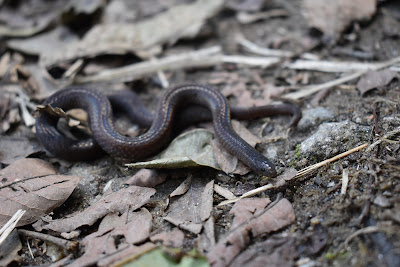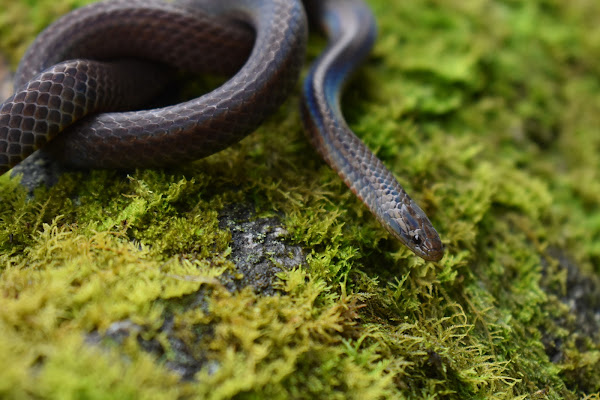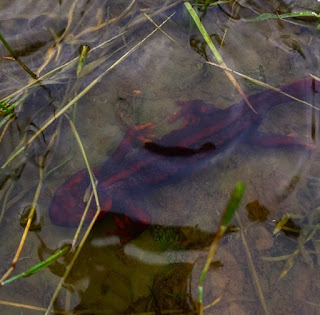Worm Eaters of D-Town
The Worm Eaters of Darjeeling.
A variety of unique and extraordinary serpents inhabit the Eastern Himalayas. The broad geography of landscapes offered and irregular variability in altitude acts as a biological niche for different species to inhabit. The wide spectrum of serpentine species include large venomous and ophiophagus Elapids such as the Bungarus niger (Black Krait), beautiful and venomous Viperids such as the Trimereserus sp. and even well known snakes such as the Indian Python ( Python molurus) and the King Cobra (Ophiophagus hannah). Besides all the unique and commonly identifiable snakes, this location also houses a peculiar subterranean cousin of your serpentine nightmares. These snakes are the harmless worm eating snakes or the Trachischium snakes. Innocent in both behaviour and appearance ( that is considering you aren’t blindly afraid of scaled animals), these snakes are one of the most common herps an individual can come across in the district of Darjeeling. If it is not clear by now, the Trachischium snakes are worm feeder hence they are incredibly well adapted to living a subterranean life. The adaption in their morphological features is so remarkable that most people confuse them for worms at certain instances.
The Trachischium are a genus under the sub family Natricinae which falls under the broader family of Colubrids. These snakes are commonly known as Oriental Slender snakes (which could be synonymous to their highly slender and worm like bodies unlike snakes like vipers) or Worm Eating snakes in general. The Trachschium snakes are called “Kukhrey Saap” in Nepali. The specific reason behind this name is something I don’t know yet although when I asked a few elders about the basis if this nomenclature, they said that these snakes are commonly preyed upon by poultry or “Kukhra” as we know. I am still not sure if this was a hilarious or serious remark. Although there are about seven species of the worm eaters, they are almost indistinguishable at a glance. A common way of identification that can be used to differentiate between the species is by observing the colour of the underbelly or the ventral snakes. This is characteristic is almost specific and unique with every species of the Trachischium snakes but the method is of course faulty. A common fault that can be observed is that the colour of the ventral scales between the T.guentheri and T.monticola, two completely different species, is almost the same, although at closer observation one maybe able to see that the underbelly of the T.guentheri is more highly pigmented (almost to a rosy maroon shade). These snakes share almost the same habitat and geographic extent of occurrence, only two of species of the worm eaters can be undoubtedly found in Darjeeling. The Trachischium snakes generally look alike with smooth ventral scales, iridescent scales dorsally, keeled tails for self defence. These are the Trachischium fuscum and the Trachischium guentheri.
1. Darjeeling Worm Eater Snake (Trachischium fuscum).
The Trachischium fuscum was first observed by English zoologist Edward Blyth in the year 1854, who initially named it Calamaria fusca. This was changed during the course of time until the species found its current taxonomical position. This snake also has a number of common names such as Darjeeling Slender Snake, Black-belly Worm Eating Snake and Darjeeling Worm Eating Snake.
• Size- It is longer when compared to its cousin T.guentheri as adults can measure to 50/51 cm easily (about 20 inches) from head to tail. Some adults have also been recorded to measure up to 70 cm (27 inches), which most likely could be the result of better habitat and plentiful availability of prey. Tails can be about 2 inches long in adults. The juvenile is almost identical to the adult but there is a significant difference in their respective lengths. These snakes don’t tend to gain much girth even after maturity and have a rather slender appearance to them.
• Description- The facial scale arrangement is pretty similar to other Trachischium snakes with single rostral, pre-frontal, nasal and post ocular scales. The intranasal scale can be seen to have a small division at closer inspection. The mid body dorsal scales are 13 in rows; the ventral scales may vary around 150 each. The anal plate is divided and the sub-caudals are mostly 23 in number. Males have minute keels located on each side of the anal slit. The head is slightly more pointed than other Trachischium snakes, giving it a more defined yet adapted for burrowing head. The eyes of this species are distinct and almost pitch-black. Body is rigid and smooth with keels dorsally and very smooth to touch ventrally. The skin almost is iridescent black to deep bluish or even greyish black depending on the individual. The dorsal scales are bordered with fine greyish white coloration in adults and are much finer or not even visible in juvenile. A singular colour pattern is present in almost all individuals except if viewed under very bright lighting, where few lines of contrasting darker shades can be seen ventrally. Sexual dimorphism in colour is probably not present. The differentiating feature of this species is its characteristic black and white ventral scales. It possesses a keeled tail like all other Trachischium snakes which is used to poke predators or observers when handled. Non venomous and possibly the most harmless snake in the district. This is present in every individual irrespective of age, habitat or sex.
• Distribution and Occurrence- Altitude above 1900 metres to 2100 metres is ideal. This species is very concentrated in Darjeeling and is one of the three most common snake species (along with Ovophis monticola and Amphiesma platyceps). Also occurs in Western Sikkim and elevated areas of Assam. Has been recorded in Nepal and Bhutan as well.
• Habitat- Found in inter montane to low coniferous and rhododendron forest. Very common in sub urban areas of Darjeeling and can be easily spotted in small pockets of vegetation in and around the town itself. The ideal habitat includes thick foliage and leaf litter. Occurs specially in oak, rhododendron, alder and birch litter with black substratum. Other vegetation includes ferns, bryophytes etc. Also seen to seek in dump sites and waste disposed in its habitat.
• Habits-Highly subterranean in nature hence very elusive. The snake can be observed out of hiding only between the months of May to early September, when cloud cover is high, rain is constant and humidity is high. Shows nocturnal behaviour as well. The diet of the species is primarily worms such as common earthworms and night-crawler worms. Also feeds on beetle grubs, insect larva and other burrowing insects and annelids. The reproductive behaviour of this species has not been properly observed. Possibly not a group breeder unlike the T.guentheri. Young can be spotted during peak Monsoon, hiding under leaf litter. The juvenile are social in nature whereas the adults seem solitary. Parental behaviour could be possibly shown as adults are often found near the juvenile. When approached, an individual will most likely try to flee from the scene either by seeking cover under foliage or burrow under the soil. If it fails to do so, it will defensively turn coil up. When handled, it can use the keel on the tip of its tail to poke. This is followed by intense defecating. Enters hibernation during mid Autumn and emerges during early Spring.
2. Günther’s Worm Eater Snake (Trachischium guentheri)
The most common of the Trachischium snakes, the T.guentheri is found in almost most of the parts of the Eastern Himalayas firstly by British-Belgian zoologist George Albert Boulenger in the year 1890 who gave it the name “guentheri” in honour of German zoologist Albert Günther. This species also has numerous common names such as Rose Belly Worm Eater, Günther’s Worm Eater Snake and Günther’s Oriental Slender Snake. Its conservation status is enlisted under Least Concern section in the IUCN.
• Size- A medium sized snake with adults measuring about 28 to 30 centimetres max. (11-12 inches). The tail can measure about 1 ½ to 2 inches. Sexual dimorphism in size is yet not observed properly although females could be slightly larger than males.
• Description- Facial scale arrangement almost same as that of T.fuscum although the head is slightly more blunt when compared, almost resembling a caecilian or other burrowing herps. The mid body scales have been observed to be 13 rows. The dorsals are keeled in males. The ventral scales are mostly about 130 in number and the anal plate is divided. Males have keels present on either inside of the anal plate. The skin is very smooth to touch and is possibly a result of its highly subterranean lifestyle. The ventral scales are distinctively rosy maroon to rusty orange in colour with white edges. The dorsal coloration is light reddish brown with streaks of dark brown and light chocolate brown. It is also mottled with other shades of brow when observed under strong lighting. The head is much lightly pigmented. The eye is rather very small and almost similar to some of the Typhlops species.
• Distribution and Occurrence-Usually recorded to occur at least above elevations of 1700-1800 metres but is more common in higher altitudes but can be found in lower altitudes if niche habitats are present. Range within India includes Northern and Western Sikkim (highly concentrated), Northern Darjeeling district and Arunachal Pradesh. Possibly occurs in other North Eastern states as well (along with the remainder of the Trachischium snakes). Also found in Nepal and Bhutan.
• Habitat-Found in montane lower, inter montane, lower alpine and even sub alpine type of vegetation. Very much subterranean and has elaborate burrow systems under foliage. Prefers leaf litter of chestnut, Utis, Shorea, oak, pine, fir etc. Can burrow up to a foot and half of leaf litter and black loamy soil. The other vegetations found in its habitat include ferns, bryophyte, shrubs and other non flowering plants. Also commonly found in human settlements and gardens where it prefers to burrow under manure and humus.
• Habits- Prefers to stay under foliage most of the time and rarely seen out of their burrowing systems. Nocturnal behaviour might be observed although is very uncertain with respect to the Darjeeling population. They prefer to stay covered under wet foliage and leaf litter most of the time. Occurrence rate is higher during late Monsoon to early fall. Diet includes worms, grubs, insect larvae and other burrowing insects. Shy feeders in comparison to the previously mentioned T.fuscum. These snakes are group breeders and breeding colonies can have number of individuals breeding in one spot. The juvenile occur in mass numbers hence making it a rather common snake in its range of occurrence. These snakes also show the same self defence behavioural pattern like the T.fuscum.
The Trachischium snakes are unique herptiles endemic to the N.E Himalayas and are an integral part of the ecosystem of our own district. These snakes are incredible worm and burrowing pest feeders and have been observed to feed bollworms and other agricultural pests. They also help in reshuffling of the foliage and soil they inhabit which is helpful for flora to flourish with proper nutrients. These snakes are also important contributors of bio mass in the ecosystem they occur in. Besides all this, they are unique and amazing organisms endemic to our hills.
Although both of the snakes are rather common, they are also prone to anthropogenic threats. The major life threat for these snakes, believe it or not, is human conflict. These harmless non venomous snakes that use their mouths for nothing besides feeding and literally possess mere keels to poke for self defence are killed relentlessly by folk who are uneducated about their basic nature. These innocent animals honestly do not deserve such malicious treatment. Rapid urbanization, habitat loss, intense deforestation and soil pollution are other major threats to these snakes.
I hope that all the readers will take something from this article and will further educate people who are not yet familiar about the innocence of these snakes,.
Thank you :)
References besides personal observations:
1. Indianreptiles.org
2. Herpetology of Nepal; Tej Kumar Shrestha
3. Trachischium sp. Wikipedia
4. Researchgate.net
5.”An Overview of the Herpetofauna of Sikkim with Emphasis on the Elevational Distribution Pattern and Threats and Conservation Issues” paper













Comments
Post a Comment